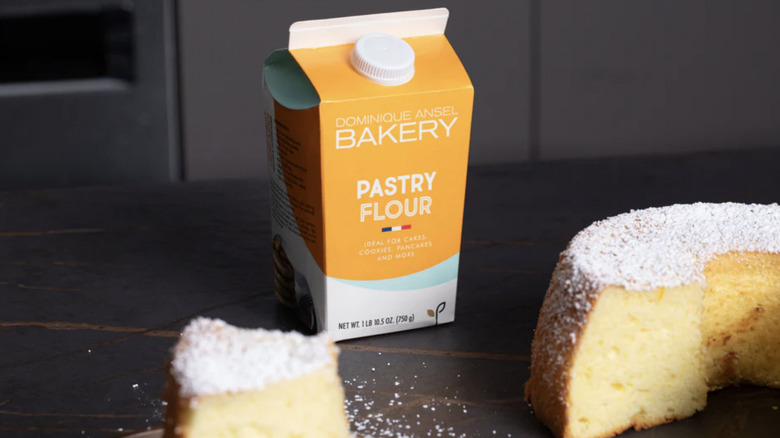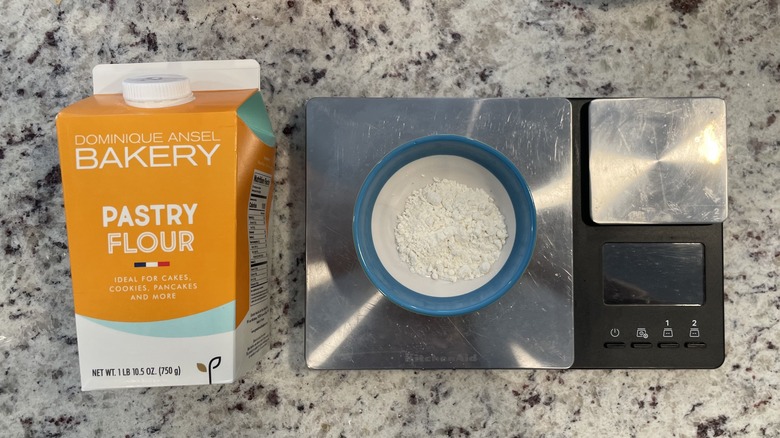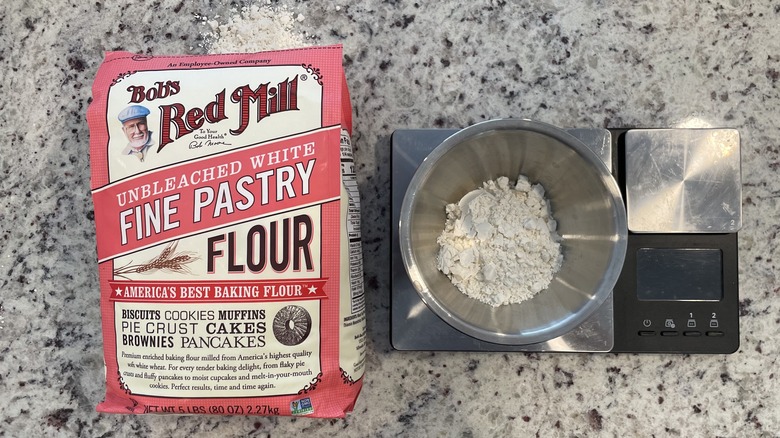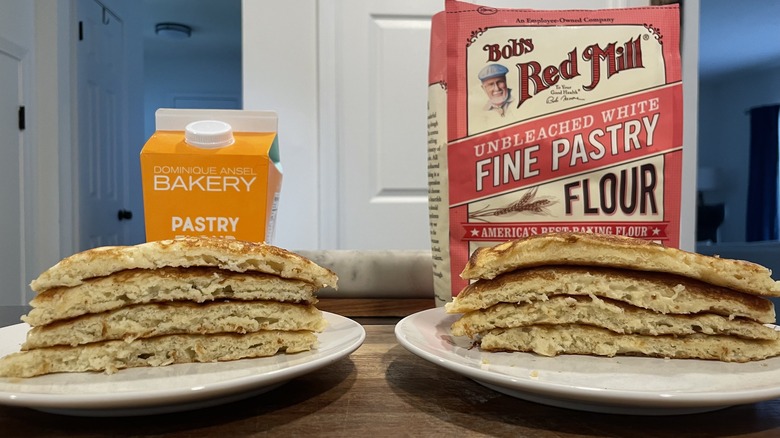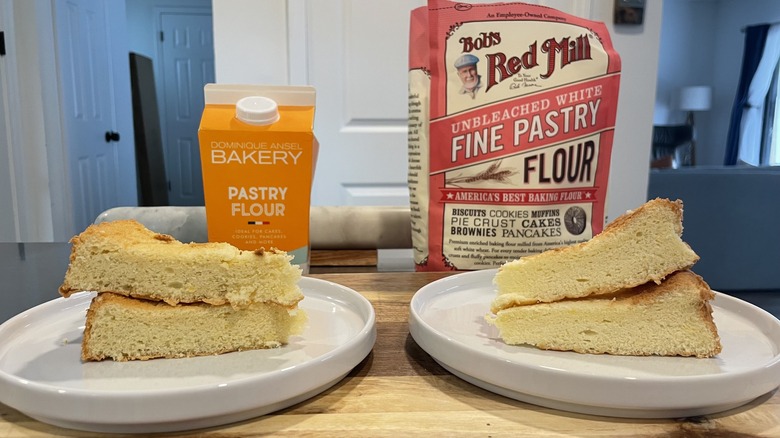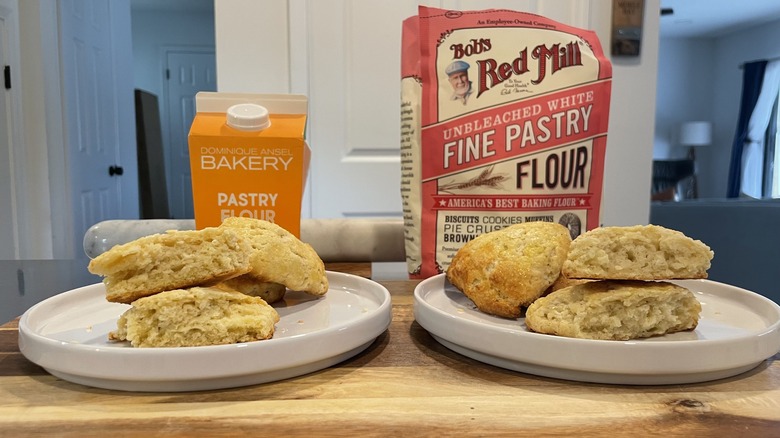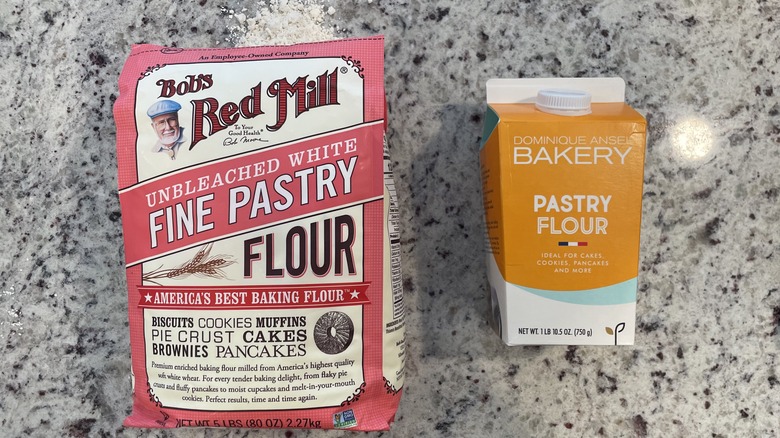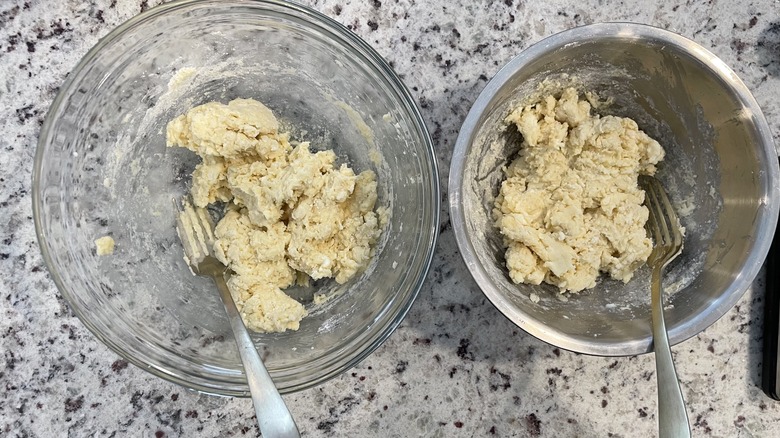Is Dominique Ansel's Pastry Flour Worth The Price?
We may receive a commission on purchases made from links.
Bakers, hear the good news: The flour section at the grocery store is growing into a wild and wonderfully diverse place. As the former managing editor of a baking magazine and avid home baker, I'm always excited to see new brands and varieties sharing the shelf with the typical all-purpose flour. No flour has proved more exciting to me than pastry flour — a soft, finely ground grain that shares many characteristics with cake flour.
What's the difference between cake and pastry flour? Generally speaking, pastry flour has a higher protein content (around 8% to 9%) and a slightly thicker grind. Because of this, pastry flour works best for — you guessed it — pastries, like hand pies and croissants, while cake flour is preferred for delicate sponge cakes. Even better, pastry flour can be used for more than just laminated, flaky doughs. Still, not all pastry flours are created equal. Take it from me: I've tried and tested numerous flour brands, and I'm always amazed at how differently each one behaves.
With that in mind, it's time to introduce the debut artisan pastry flour I'll be reviewing, Dominique Ansel' Bakery's Pastry Flour. A collaboration between famed baker Dominique Ansel and Grands Moulin de Paris, a 100-year-old milling company, this is the first time this French flour is available for home bakers in the United States. And, as you might expect, this fine product comes with a significant price tag. So we had to ask: Is it worth the splurge?
A look at Dominique Ansel's pastry flour
Before I start baking with this flour, let's take a closer look at what this product is. According to the Dominique Ansel website, this high quality pastry flour is essentially a T55 flour, a specialty French flour with a finer grind and lower gluten level than typical American all-purpose flour. Mostly associated with croissant making, T55 should be used with more delicate baked goods, like sponge cakes and pastries. Milled in France by Grands Moulin de Paris, the flour comes from 100% French soft wheat, which is part of the secret to its tender texture.
Though Grands Moulin de Paris may not be a known name in America, it's a very well respected brand in France, supplying one-third of the bakeries there with its flour. Dominique Ansel is one such happy customer, saying, "In our kitchens, we use Grands Moulins de Paris flour for many of our pastries, and it helps us to achieve that flaky, light and airy texture."
Recommended for using in pancakes, cakes, cookies and more, the flour itself has a shelf life of 5 to 6 months, which is a bit shorter than your plain bag of all-purpose flour. Still, since it's sold in a smaller container (750 grams per bag), it doesn't seem like a big ask to use that amount up in half a year. You can currently buy it for $8.50 on Amazon (complete with free shipping) or for $10.50 on the Dominique Ansel website.
Comparing with Bob's Red Mill pastry flour
To evaluate the Dominique Ansel pastry flour, I needed to select a more affordable and familiar domestic pastry flour product to compare it with — one you can easily track down at your local grocery store. I landed on Bob's Red Mill Unbleached White Fine Pastry Flour ($13.30 for a 5-pound bag) as it's an affordable yet quality option, that I've had success with in the past. I also appreciated that it was a bit cheaper than the great King Arthur Pastry Flour ($12.95 for a 3-pound bag) as well.
Though a specific protein content isn't mentioned on the site, a staff member confirmed on the website that you can expect it to fall within the standard 8% to 9% range. As for its suggested uses, Bob's Red Mill lists out everything from biscuits to brownies, even suggesting it as a fine replacement for cake flour in any recipe that calls for it.
Beyond sharing the similar term "pastry flour," the Bob's Red Mill version seems to share very little in common with the Dominique Ansel's pastry flour. One flour is harvested and milled in France, the other in the United States. In addition to being nearly half the cost, BRM flour is also easier to find at the stores. Most notably, this flour has a shelf life of two years versus the other pastry flour's 6-month deadline. With all this separating the two, would the two brands behave all that differently during baking?
The pancake test
My first baking field test relied on a pancake recipe located on the back of the Dominique Ansel's pastry flour carton called "Fluffiest Pancakes." It seemed a good place to begin evaluating its mettle, as the recipe was developed to help show the flour in its best light.
When using Ansel's pastry flour, I was happy to see that the flour didn't clump very much when I mixed in the buttermilk (the secret to upgraded pancakes), melted butter, and eggs, an issue that can be caused by less finely-milled flours. The resulting texture was smooth and loose, exactly what I expect from pancake batter. This batter cooked up into lofty, fluffy pancakes with a very tender crumb.
Working with the same recipe, the BRM flour seemed to behave much in the same way, but things get tricky when adding in the buttermilk. The batter was slightly thicker than the batter made with Ansel's pastry flour. Why? It might have something to do with the absorption rate of the flour. The higher the protein level, the more moisture the flour will absorb, which can change the fundamental texture of your baked goods. I can only assume that the protein level was higher in the BRM flour, as it seemed to absorb more buttermilk and create a thicker pancake batter. This made the pancakes cook slower and less evenly than the ones made with Ansel's flour. Because of this, Ansel's pastry flour was the clear winner for the better pancake.
The sponge cake test
My next test focused on how the two flours would work in creating a sponge cake. The recipe I selected came from renowned baker Claire Saffitz, and relied on both a whipped egg white foam and a whipped egg yolk foam for its lofty texture. The flour required to make this cake is only a small amount (less than a cup), but the type of flour is crucial. Cake flour is one of the secrets to making a perfect angel food cake, because a lighter, lower protein flour is needed to keep from collapsing the delicate bubbles created by the egg foams. Pastry flour should work the same way.
When using Dominique Ansel's pastry flour for this recipe, I was once again pleased at how easily the flour mixed into the wet ingredients, even without me sifting it in. It's got some magical anti-clump properties, I swear. By conclusion of baking, it had created a good sponge cake that was only slightly deflated thanks to a clumsy turn out on the cooling rack.
Interestingly enough, the BRM pastry flour worked just as well, avoiding weighing down the delicate cake batter and folding in neatly. While it looked slightly better than the other sponge cake, it was only because of my mishandling the pan. In fact, the cakes had an almost identical texture and taste. For that reason, I would have to select the cheaper option as being the winner, since I couldn't truly discern a difference.
The scone test
Scones (and/or biscuits) definitely benefit from using pastry flour, as a tender texture makes all the difference. I selected a simple cream and butter scone recipe from Once Upon a Chef to test out the two pastry flours (although our mixed berry scones recipe is worth looking at too). The recipe original called for cake flour, but I thought pastry flour would work very well in its place.
While I had previously been impressed with Ansel's flour before, the scone test is where this artisan flour truly shined. It came together into an easy, malleable dough and baked into a superior scone. Melt-in-your-mouth may seem like a cliché expression, but this dish actually earned it.
Meanwhile, the BRM pastry flour did not come together as easily. Like with the pancakes, the flour ended up absorbing more heavy cream than the Dominique Ansel pastry flour, which meant I had to add up to two extra tablespoons of cream to make a pliable dough. This isn't to say the BRM pastry flour didn't make a good scone, as the results were still delicious and tender. Still, it's like the difference between a feather-down pillow and a memory foam pillow; both are soft, but the memory foam makes you feel like you're sinking into velvet rather than sinking into a bed. It's transcendent. For me, the Dominique Ansel pastry flour takes the gold.
My baking conclusions
After all of this testing, the answer to whether Dominique Ansel's pastry flour is worth it is yes, but with a caveat. If you're looking to make a superior scone, biscuit, or pie, this flour is worth it. Even if you want to make a divinely delicate quick bread or pancake, I think this pastry flour will outdo other brands. But if you're using only a small amount of the flour — say, less than a cup for a sponge cake — it won't make enough of a difference to be noticeable.
During my review, I also had a few takeaways on the flour's innovative packaging. On the one hand, I appreciate the recycled cardboard carton material, as it offers a more airtight and eco-friendly option to the typical flour paper sacks. Plus, I found the spout opening made pouring out flour very easy. On the other hand, if I measured out too much flour, I had to use a funnel to correct my mistake and add the excess flour back to the container. This may seem like a nitpick, but considering the price of this flour, every gram of is worth saving. Overall, I like packaging, but it's not the true selling point for me. It's what's on the inside that counts, after all.
My methodology
During testing, I used the aforementioned pastry flours as well as generic sugar, eggs, and non-European style unsalted butter. I weighed every ingredient — a kitchen scale is an essential baking tool, change my mind — in order to insure that each baked good received an even ratio of ingredients. Each batter/dough was baked in the same pan and cooled on the same cooling rack.
I selected pancakes, scones, and sponge cake as I found them to provide a nice spread of various baked good textures. I also thought that the pancakes worked as a good representative for how the flour would behave in making pancakes, crumpets, or other similar style batters. Scones, too, are a good stand-in for how the flour will work in pie dough, biscuits, or pastry crusts.
A note on my expertise as a baker: I have previously worked as the managing editor at a baking magazine and tested numerous recipes during my time there. I have extensive experience with flour, and have baked with various brands and flour types, from the weird (musty chestnut flour) to the wonderful (buttery semolina flour).
